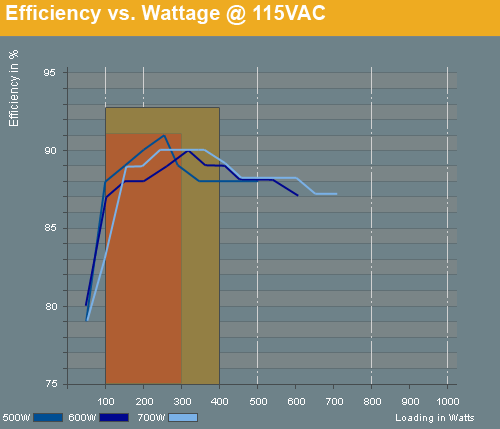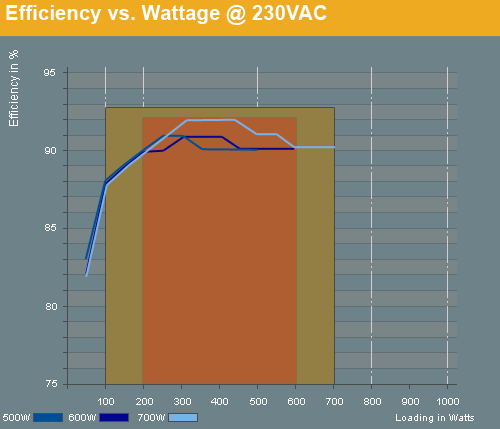Enermax Gold: Modu87+ and Pro87+
by Christoph Katzer on January 19, 2010 1:00 PM EST- Posted in
- Cases/Cooling/PSUs
Efficiency Comparison and How to Choose Your PSU
We wanted to explain to you how much power your system should actually use so you can make the best use of your new power supply. Of course you can load these power supplies up to the limit and still have around 87% efficiency - a result that many cheaper power supplies cannot reach even at their ideal load. However, these graphs show you where these power supplies reach their best efficiency.

From 100 to around 400W you will get maximum efficiency if you're on a 115VAC grid. That will provide you with an 88-91-88-percent curve with the 500W unit, an 87-90-89-percent curve with the 600W unit, and an 83-90-89-percent curve with the 700W unit. If you want even better efficiency you would want to be in the darker red area of 100 to 300W output. We've combined all three PSUs on one chart, however, so you will want to consider the curves and adjust your PSU selection as appropriate, e.g. the 700W PSU performs best with a load of at least 150W.

With 230VAC our recommendations look quite different. Users on a 230VAC grid can use any of these three units with any kind of load and achieve very good efficiency. Even at 5% load all of the units are still well above 80%, which is something that was difficult to reach a few years back. If you really want to squeeze the best results out of your units you will want load of at least 100W up to the maximum rated output of the PSU. That is a very large area and it shows how versatile these PSUs are. If your system uses 200W to 600W you will be able to maintain a constant efficiency of over 90%! In short, hook up just about any system to these power supplies on a 230V grid and you can be sure you'll be truly energy efficient.
Just to put things in perspective, the 80 Plus certification was introduced a few years back to put public focus on more energy efficient products, mainly power supplies. In the beginning there was only one certification, but since the initial introduction the group behind the certification has felt it necessary to introduce additional levels of efficiency. Today, we have Bronze, Silver, and Gold, with Gold being the highest level of the 80 Plus and presenting a very difficult target for the PSU manufacturers. The race to Gold has now been won, but now there's a new target in sight: Platinum. The required efficiencies for the different levels are listed below.
| 80 Plus Certification Requirements | |||
| 20% Load (Light) | 50% Load (Typical) | 100% Load (Full) | |
| 80 Plus Standard | 80% | 80% | 80% |
| 80 Plus Bronze | 82% | 85% | 82% |
| 80 Plus Silver | 85% | 88% | 85% |
| 80 Plus Gold | 87% | 90% | 87% |
| 80 Plus Platinum (230VAC only) | 90% | 94% | 91% |










59 Comments
View All Comments
FaaR - Thursday, January 21, 2010 - link
You're too focused on price only. A PSU isn't something you buy every day. Better to get a great, efficient unit that has headroom to grow and will last you many years, even if it costs a little more.And yes, fifty bucks is a little more. Most people on Anandtech wouldn't whine if they have to pay $200 for a video card, and we all know how fast they go obsolete. Get some perspective here please.
The PSU is arguably THE most important piece of equipment in your whole PC. If it doesn't function well, nothing else will either. So there's nothing wrong with buying one of the best units out there, quite the opposite.
Kibbles - Friday, January 22, 2010 - link
Actually this is more like a $600-700 videocard amongst PSUs. Most will be happy enough with a HD5870. Many PSUs in the $100 range, like the HX620, are damn good. However like any other computer component, those extra 5% costs just as much as the first 95%.Spacecomber - Tuesday, January 19, 2010 - link
I happy to see another P/S review on Anandtech. I don't think that there have been any in quite a while. While these Enermax models are very nice, the price probably makes them impractical for any builds that I can imagine.However, one thing that I really like about these power supplies is their very low noise output. As I move away from building game-centric computers to computers that are likely to be used more as media servers, keeping the noise down to being virtually inaudiable becomes more important to me (especially for a music server). For these kind of computers I don't need a huge amount of power, and therefore I'm not looking to invest a huge amount of money in the P/S. I'm really looking for a power supply that can give me the quietest experience for the least amount of money. (To get a really quiet P/S, I accept that I'll be spending more than one would expect to spend on most "budget" power supplies.)
Anyway, this is just a suggestion that perhaps others are also looking for something more like this for their living rooms, instead of a kilowatt P/S to drive an overclocked quad core monster with multiple video cards.
- Tuesday, January 19, 2010 - link
The first three graphs on p.11 look like they need more labeling. Looks like you need to show which PSU for efficiency.mariush - Wednesday, January 20, 2010 - link
On page 10, I somehow doubt the readings were made at 50C room temperature (see chart headers)JarredWalton - Thursday, January 21, 2010 - link
As mentioned below, the tested was done in a temperature controlled chamber, so the ambient temp was indeed 50C. I would update the graphs, but Christoph custom-made these charts so I'll leave that to him. :)JarredWalton - Tuesday, January 19, 2010 - link
Fixed... the same graph was initially inserted on all three as you may have noticed.markshin - Saturday, July 24, 2010 - link
i bought a Modu87+ 700W, because i needed a new psu to replace my 5-year old 70% efficient unit..I don't intend to run this at 100% load, that's sheer madness. 30-60% is the sweet spot for today's PSU's, that's where they are most efficient.
and also, they're selling for about US$150 (at least from where I'm located).
:-)
MasonStorm@AnandTech - Friday, October 1, 2010 - link
Hi Chris,Thanks for the great review. Any chance you can update the results to include the new, 800W and 900W models they've just released? I'd love to see if those also stay silent at all loads.